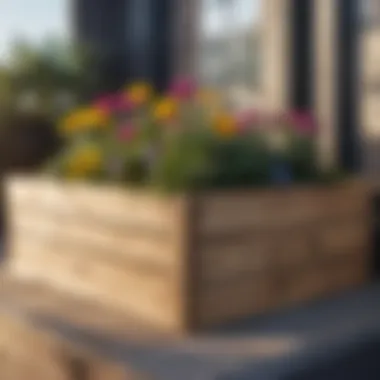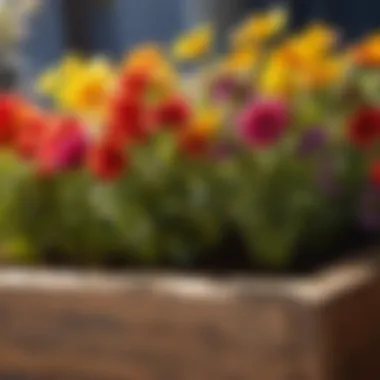Materials:
- Pressure-treated wood (2 pieces of 2x12x8ft and 2 pieces of 2x12x6ft)
- Wood screws (3-inch)
- Power drill
- Waterproof wood glue
- Geotextile fabric
- Staple gun
- Potting soil
- Your choice of plant seeds or plants
DIY Steps:
-
Preparation: Begin by measuring and cutting the wood to the desired dimensions for the flower box. Cut the 2x12x8ft pieces into two 4-foot lengths and two 2-foot lengths. For the 2x12x6ft pieces, cut them into two 3-foot lengths.
-
Assembly: Use the power drill and wood screws to attach the longer pieces to the shorter pieces, forming a rectangular box shape. Apply waterproof wood glue along the seams for added security.
-
Lining: Line the inside of the box with geotextile fabric to prevent soil erosion and improve drainage. Use a staple gun to secure the fabric in place.
-
Planting: Fill the box with potting soil and add your chosen plant seeds or plants according to your preference and design vision.
Technical Aspects:
- Ensure the wood is pressure-treated for durability and longevity, especially if the flower box will be exposed to outdoor elements.
- Use 3-inch wood screws for secure fastening, preventing the wood from splitting.
- Apply waterproof wood glue sparingly to avoid excess seepage while providing adequate bond strength.
- Geotextile fabric aids in moisture regulation and prevents soil compaction, promoting healthy plant growth.
DIY Project Process:


-
Light Care for Begin with: Start by placing the flower box in an area with sufficient sunlight and water the plants as needed, avoiding over-watering.
-
Plant Maintenance: Regularly monitor plant growth, trimming or repotting as necessary to maintain the aesthetics of the flower box.
Troubleshooting Tips:
-
Drainage Issues: If excess water accumulates in the box, drill small holes at the base for improved drainage.
-
Soil Compaction: Gently aerate the soil with a small fork to prevent compaction and promote root health.
Introduction


Creating a custom flower box is a rewarding project that allows you to add a personalized touch to your garden or home exterior. In this detailed guide, we will walk you through the process of designing and building a flower box from scratch. From selecting the right materials to planting vibrant flowers, each step plays a crucial role in bringing your vision to life. Whether you're a seasoned DIY enthusiast or a beginner looking to enhance your outdoor space, this guide will equip you with the knowledge and skills needed to create a stunning flower box.
When it comes to introducing the topic of creating a custom flower box, it's essential to emphasize the creativity and customization involved. Unlike ready-made flower boxes, crafting your own allows you to tailor every aspect to suit your preferences, from the type of wood used to the color of the paint. This personalization not only enhances the aesthetics of your space but also gives you a sense of accomplishment knowing that you've built something unique. Additionally, building a flower box provides an opportunity to engage in a hands-on project that fosters creativity and improves your outdoor living environment. By following this comprehensive guide, you'll be able to transform your outdoor space with a beautiful and functional custom flower box.
Materials Needed


In this guide for creating a custom flower box, the choice of materials plays a pivotal role in ensuring the durability, aesthetics, and functionality of the final product. By meticulously selecting the right materials, you can enhance not only the visual appeal of the flower box but also its longevity. The materials needed section covers various aspects such as wood, tools, and optional materials, each contributing uniquely to the overall project.
Wood
Selecting the Right Type of Wood
Choosing the appropriate type of wood is crucial when crafting a flower box. Factors such as weather resistance, durability, and aesthetic appeal should be considered. Cedar and redwood are popular choices due to their natural resistance to rot and insects, making them ideal for outdoor use. Pine, while more economical, may require treatment to enhance durability.
Measuring and Cutting the Wood
Accurate measurements and precise cutting are essential for the success of your flower box project. Utilizing a quality measuring tape and saw will ensure that each piece fits together seamlessly, resulting in a sturdy and well-constructed box.
Tools
Essential Tools for Building the Flower Box
The use of essential tools such as a hammer, nails, drill, and level are indispensable for assembling the flower box. These tools facilitate the construction process, aiding in ensuring accurate measurements and secure connections.
Safety Equipment
Prioritizing safety during construction is paramount. Safety goggles, gloves, and a dust mask are vital considerations to protect yourself from potential hazards such as wood splinters and dust.
Optional Materials
Paints and Stains
Adding a coat of paint or stain not only enhances the appearance of the flower box but also provides additional protection against the elements. Choose a high-quality outdoor paint or stain that complements your outdoor space's aesthetic.
Decorative Accents
Incorporating decorative accents such as embellishments or carved designs can elevate the overall look of the flower box. Whether opting for intricate details or a minimalist approach, decorative accents add a personalized touch to the final product.
Building the Flower Box
In this article focused on creating a custom flower box, the section on building the flower box holds significant importance. Building the flower box sets the foundation for the entire project, ensuring the structure is sturdy and functional for showcasing beautiful flowers. The choice of materials and the accuracy in assembly play crucial roles in the longevity and aesthetics of the flower box.
Assembly Process
The assembly process, a pivotal step in crafting a custom flower box, involves meticulous attention to detail to ensure a seamless construction. Following step-by-step instructions is paramount to the success of this phase, guiding builders through each stage with precision. The step-by-step instructions provide a structured approach, making the assembly process more manageable and error-free, even for beginners.
Step-by-Step Instructions
The step-by-step instructions offer a clear outline of how to assemble the flower box, starting from laying out the pieces to securing them together. This methodical approach allows builders to progress systematically, avoiding potential mistakes and ensuring the final product meets desired specifications. The comprehensive nature of these instructions simplifies the assembly for individuals of varying skill levels, making it an invaluable component of this guide.
Securing the Corners
Securing the corners of the flower box is a critical aspect that contributes to its stability and durability. By reinforcing the joints at the corners, builders enhance the structural integrity of the box, preventing potential damage or weakening over time. This meticulous attention to detail in securing the corners ensures a reliable and long-lasting flower box, capable of withstanding environmental factors and the weight of soil and plants.
Finishing Touches
The finishing touches add the final polish to the custom flower box, elevating its visual appeal and protecting it from elements. Sanding the surface smoothens any rough edges or imperfections, creating a seamless finish that enhances the box's aesthetic. Applying a protective coating not only adds a layer of defense against moisture and sunlight but also imparts a glossy sheen, further enhancing the box's charm.
Sanding the Surface
Sanding the surface of the flower box is a crucial step to create a professional-looking final product. This process ensures that the wood is smooth to the touch, removing any splinters or rough patches that may detract from the box's appearance. By investing time in sanding, builders guarantee a high-quality finish that adds a touch of refinement to the overall presentation.
Applying Protective Coating
Applying a protective coating serves dual purposes in safeguarding the flower box against external elements and enhancing its visual allure. The protective coating acts as a shield, warding off moisture, UV rays, and other potential harms that could degrade the wood over time. Additionally, the coating often gives the box a lustrous finish, enriching the natural color of the wood and adding a layer of sophistication to the final product.
Planting Flowers
In the process of creating a custom flower box, planting flowers is a crucial step that brings life and vibrancy to your green space. Selecting the right flowers can set the tone for your garden and elevate its visual appeal to new heights. By carefully considering factors such as sunlight requirements, color coordination, and arrangement techniques, you can create a captivating floral display that enhances the overall aesthetic of your outdoor area.
Choosing the Right Flowers
When it comes to choosing the right flowers for your custom flower box, there are several key elements to keep in mind to ensure a successful and visually pleasing result.
Considering Sunlight Requirements
One essential aspect to consider when selecting flowers is their sunlight requirements. Understanding the amount of sunlight different flowers need is crucial for ensuring they thrive in your specific garden environment. Some plants thrive in full sunlight, while others prefer shaded areas. By matching the sunlight requirements of your chosen flowers with the conditions of your garden, you can create an optimal growing environment that promotes healthy plant development.
Selecting Complementary Colors
Another important consideration when choosing flowers for your custom flower box is selecting complementary colors. The color scheme of your floral arrangement plays a significant role in creating visual harmony and impact. By selecting flowers that complement each other in color, you can create a cohesive and visually appealing display. Consider factors such as color intensity, contrast, and harmonious combinations to achieve a balanced and eye-catching look that enhances the overall beauty of your garden.
Arranging the Flowers
Once you have chosen the right flowers for your custom flower box, arranging them effectively is key to achieving a stunning and well-balanced composition that showcases the beauty of each plant.
Creating a Balanced Composition
Creating a balanced composition involves strategically placing flowers in a way that distributes visual weight evenly throughout the arrangement. By considering factors such as flower heights, colors, textures, and shapes, you can achieve an aesthetically pleasing balance that draws the eye and creates a sense of harmony. Balancing focal points, colors, and flower types within the arrangement is essential for creating a visually engaging display that highlights the unique characteristics of each plant.
Layering Techniques
Layering techniques in flower arrangement involve stacking different flowers on top of each other to create depth and visual interest. By layering flowers with varying heights, colors, and textures, you can add dimension to your floral display and create a dynamic visual impact. Experimenting with different layering techniques allows you to play with depth and perspective, enhancing the overall beauty and complexity of your flower box design.
Maintenance Tips
In the realm of flower box care, maintenance tips play a crucial role in ensuring the longevity and vitality of your botanical display. Comprising watering, fertilizing, and seasonal care, a structured maintenance routine is essential for nurturing vibrant blooms and healthy plants within your custom flower box. By delving into the specifics of maintenance, you can elevate your gardening prowess and witness the fruits - or in this case, the flowers - of your labor flourish. Strategic maintenance not only enhances the aesthetic appeal of your flower box but also fosters a nurturing environment for your plants to thrive. Make sure to take the time to dive into the intricate details of caring for your flower box to truly transform it into a stunning botanical masterpiece.
Watering and Fertilizing
Proper Watering Schedule
Crafting a proper watering schedule is a fundamental aspect of flower box care that can make or break the health of your plants. Determining the optimal watering frequency and the right amount of water to provide each plant is vital for preventing issues such as overwatering or under-watering. The key characterist this include optimal hydration levels for various plant species and the importance of adjusting watering routines based on seasonal changes. Implementing a proper watering schedule not only sustains plant health but also promotes consistent growth and blooming.
Choosing the Right Fertilizer
Selecting the right fertilizer is a critical decision that directly impacts the nutrient uptake and overall health of your plants. Understanding the specific nutrient requirements of your flowers and opting for a well-balanced fertilizer blend is paramount for maximizing growth and floral production. The unique feature of a well-suited fertilizer lies in its ability to provide essential nutrients that may be deficient in the soil, fostering robust growth and vibrant blooms. While the advantages of using the right fertilizer are numerous, it is essential to be mindful of potential disadvantages, such as the risk of over-fertilization. Careful consideration of the fertilizer's components and application guidelines is key to harnessing its benefits effectively.
Seasonal Care
Protecting from Frost
Shielding your flower box from frost damage is a crucial aspect of seasonal care, especially in regions prone to chilly temperatures. The key characteristic of protecting your plants from frost lies in implementing preventative measures to insulate them from freezing conditions. Utilizing frost cloths, mulch, or relocating potted plants indoors during frost warnings are effective strategies to safeguard your blooms. The unique feature of frost protection is its ability to preserve plant vitality and prevent cold-induced damage, ensuring continued growth and floral abundance.
Summer Maintenance
Embarking on summer maintenance practices is essential for sustaining the health and vibrancy of your flower box during the warmer months. The key characteristic of summer maintenance encompasses tasks such as adequate watering, pruning, and pest control to combat the challenges posed by increased temperatures and sun exposure. By regularly monitoring plant hydration, removing wilted blooms, and addressing pest infestations promptly, you can uphold the beauty and vitality of your floral display throughout the summer season. The unique feature of summer maintenance lies in its proactive approach to mitigating environmental stressors and preserving the aesthetic appeal of your flower box.





